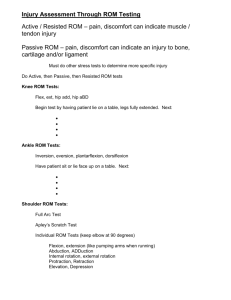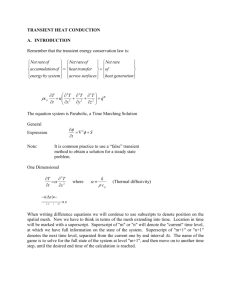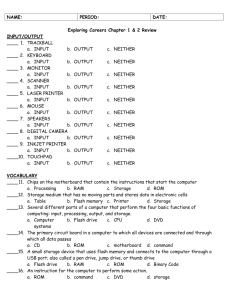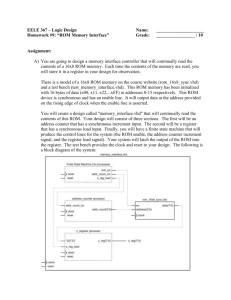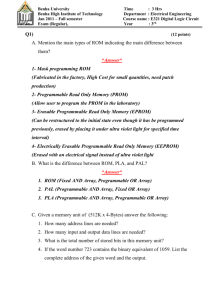romram_vhdl0
advertisement
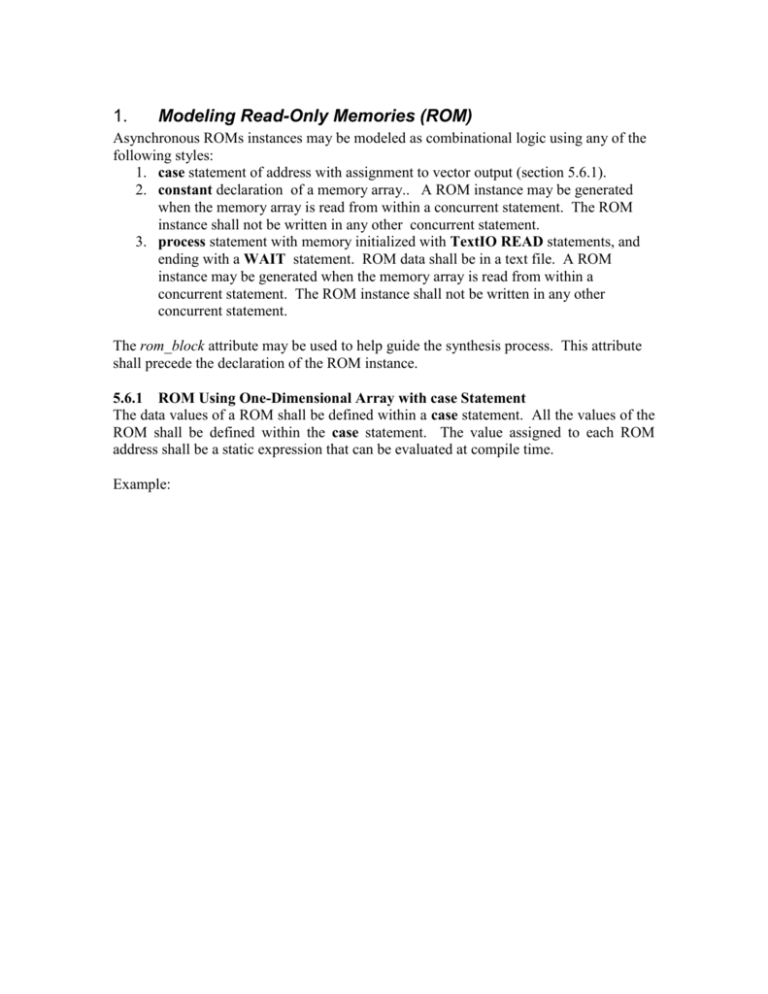
1. Modeling Read-Only Memories (ROM) Asynchronous ROMs instances may be modeled as combinational logic using any of the following styles: 1. case statement of address with assignment to vector output (section 5.6.1). 2. constant declaration of a memory array.. A ROM instance may be generated when the memory array is read from within a concurrent statement. The ROM instance shall not be written in any other concurrent statement. 3. process statement with memory initialized with TextIO READ statements, and ending with a WAIT statement. ROM data shall be in a text file. A ROM instance may be generated when the memory array is read from within a concurrent statement. The ROM instance shall not be written in any other concurrent statement. The rom_block attribute may be used to help guide the synthesis process. This attribute shall precede the declaration of the ROM instance. 5.6.1 ROM Using One-Dimensional Array with case Statement The data values of a ROM shall be defined within a case statement. All the values of the ROM shall be defined within the case statement. The value assigned to each ROM address shall be a static expression that can be evaluated at compile time. Example: library ieee; use ieee.std_logic_1164.all; entity ROM is port ( Z : out std_logic_vector(3 downto 0); a : in std_logic_vector(2 downto 0)); end entity ROM; architecture RTL of ROM is type mem_typ is array(0 to 3) of std_logic_vector(3 downto 0); -- * synthesis, rom_block = "ROM_CELL XYZ01" * signal rom : mem_typ; begin -- architecture RTL Rom_Proc : process (a) is begin -- process Rom_Proc case a is when "000" => Z <= "1011"; when "001" => Z <= "0001"; when "100" => Z <= "0011"; when "110" => Z <= "0010"; when "111" => Z <= "1110"; when others => Z <= "0000"; end case; end process Rom_Proc; end architecture RTL; Note: See section 6.1 for additional information on the definition of the synthesis attributes. 5.6.2 ROM with constant declaration of a memory array The values of the ROM may be defined within a constant defined as a two-dimensional array. A rom_block or logic_block attribute may be necessary to guide the synthesis style of the synthesis tool. Example: library ieee; use ieee.std_logic_1164.all; use ieee.numeric_std.all; entity ROMconst is port ( Z : out std_logic_vector(3 downto 0); a : in std_logic_vector(2 downto 0)); end entity ROMconst; architecture RTL of ROMconst is type mem_typ is array(0 to 7) of std_logic_vector(3 downto 0); -- * synthesis, rom_block = "ROM_CELL XYZ01" * constant ROMINIT : mem_typ := ( 0 => "1011", 1 => "0001", 2 => "0011", 3 => "0010", 4 => "1110", others => "0000"); begin Z <= ROMINIT(TO_INTEGER(UNSIGNED(A))); end architecture RTL; Note: If combinational logic is desired, replace the --* synthesis, rom_block = "ROM_CELL XYZ01" * attribute with the --* synthesis, logic_block * attribute in the above example. 5.6.3 ROM Using Two-Dimensional Array with Data in Text File FIX English … process statement with memory initialized with TextIO READ statements, and ending with a WAIT statement. ROM data shall be in a text file. A ROM instance may be generated when the memory array is read from within a concurrent statement. The ROM instance shall not be written in any other concurrent statement. library ieee; use ieee.std_logic_1164.all; use ieee.numeric_std.all; use ieee.std_logic_textio.all; use std.textio.all; entity ROMfile is port ( Z : out std_logic_vector(3 downto 0); a : in std_logic_vector(2 downto 0)); end entity ROMfile; architecture RTL of ROMfile is type mem_typ is array(0 to 7) of std_logic_vector(3 downto 0); -- * synthesis, rom_block = "ROM_CELL XYZ01" * signal ROM : mem_typ; begin ROmInitTerxtIO_PRoc: process is file romdata_f : text open read_mode is "romdata.txt"; variable L : line; variable I : Natural; variable V : std_logic_vector(3 downto 0); begin -- process ROmInitTerxtIO_PRoc I := 0; File_Lp :while not Endfile(romdata_f) loop ReadLine(romdata_f, L); Read(L, V); ROM(I) <= V; I := I + 1; end loop File_Lp; wait; end process ROmInitTerxtIO_PRoc; Z <= ROM(TO_INTEGER(UNSIGNED(A))); end architecture RTL; 5.7 Modeling Random Access Memories (RAM) … from Verilog … not finished for VHDL. Synchronous RAMs shall be modeled as a two-dimensional array. The data entry into the RAM shall be modeled as a clocked block, and the asynchronous READ shall be modeled as either an assign statement or a combinational block. Two RAM style attributes may be used to help guide the synthesis process. The following restrictions shall apply: 1. The RAM shall be defined as a two-dimensional array. 2. An attribute may be necessary to identify the RAM style (* synthesis, ram_block *) for RAM cells, or (* synthesis, reg_block *) for registers. Example: // Verilog-95 style module ram_test(q, a, d, we, clk); output [7:0] q; input [7:0] d; input [6:0] a; input clk, we; (* synthesis, ram_block *) reg [7:0] mem [127:0]; always @(posedge clk) if(we) mem[a] <= d; assign q = mem[a]; endmodule // Verilog-2001 style module ram_test( output wire [7:0] q, input wire [7:0] d, input wire [6:0] a, input wire clk, we); (* synthesis, ram_block *) reg [7:0] mem [127:0]; always @(posedge clk) if(we) mem[a] <= d; assign q = mem[a]; endmodule //Ram implemented with latches // Verilog-95 style module ramlatch (q, a, d, we); output [7:0] q; // output input [7:0] d; // data input input [6:0] a; // address input we; // clock and write enable // memory 128 deep, 8 wide (* synthesis, ram_block *) reg [7:0] mem [127:0]; always @* if(we) mem[a] <= d; assign q = mem[a]; endmodule //Ram implemented with latches // Verilog-2001 style module ramlatch ( output wire [7:0] q, // output input wire [7:0] d, // data input input wire [6:0] a, // address input wire we); // clock and write enable // memory 128 deep, 8 wide (* synthesis, ram_block *) reg [7:0] mem [127:0]; always @* if(we) mem[a] <= d; assign q = mem[a]; endmodule
